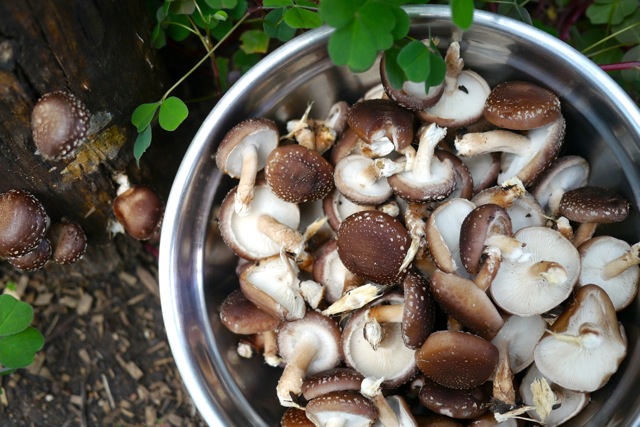
As if growing your own mushrooms wasn’t excellent enough, there’s also a way you can further increase their Vitamin D content… simply by putting them in sunlight.
And not increase that Vitamin D by a little bit, either. We’re talking a bigtime boost in nutrition here.
This technique applies at least to shiitake mushrooms (our favourite) and button mushrooms, but may also apply to other types of mushrooms too.
But shiitakes and button (field) mushrooms are the ones that have been most studied on this front, so let’s go with what we know.
We first heard about this technique via the fabulous Paul Stamets of Fungi Perfecti.
And to us, it just goes to show yet another level of amazing that the world of mushrooms has up it’s sleeve (or gills, I suppose).
So – the summary is this:
When exposed to sunlight for two days, shiitake and button mushrooms inherently increase their Vitamin D content.
And it’s not a small increase. Their Vitamin D content soars. To 460 times that of a non-sun-exposed mushrooms.
The best bit? It’s not only fresh mushrooms that seem to take on this increase in Vitamin D. Dried mushrooms can also increase rapidly in Vitamin D if previously not exposed to sunlight.
Points of note in this process:
– According to Paul Stamets, 2 days of sunlight exposure is the sweet spot. After that period of time, the Vitamin D decreases from it’s highest levels, possibly due to over exposure to sunlight.
– Sliced mushrooms gain more Vitamin D in this process than whole mushrooms, due to increased surface area exposure.
– As said above, you can do this with pre-dried mushrooms as well to increase their Vitamin D content (although I couldn’t find any info on the exact results of this, only that the levels increased)
– Placing the shiitakes under a UV light for the same period will have the same effect, but sunlight is footprint-free.
– Apparently a small handful of these (10g) four times a week is equivalent to all the Vitamin D a vegan needs to thrive, so take note, meatless folk!
– Vitamin D is one of those vitamins you can take too much of if you try hard enough, so don’t eat kilos of these every day. Not that we think you would.
How to do it:
- Grow some shiitake mushrooms (or buy some).
- Place your freshly harvested and cleaned mushrooms outside in a sunny spot, for the equivalent of two days of sunlight.
- If using whole mushrooms, place them gills upward.
- Cover your mushrooms overnight (or bring them inside) as you would for any sun-exposed food of this kind.
- After two sunny days, proceed to dry mushrooms with your normal technique, or alternately, eat them.
We went with mostly whole mushrooms, partly because i’m so in love with the idea of having jars of whole dried home grown shiitakes in our kitchen.
For the rest of the drying process, we used a few methods.
Mostly we dried them whole (little ones) and sliced (big and wonky ones) in our excalibur food dehydrator which continues to be an awesome tool for preserving the harvest.
We also dried a bunch of sliced shiitakes in the bottom of the woodstove, because it was lit one night. Free heat energy is not to be sniffed at, I figure.
A great stash of home-grown, organic sustenance for winter and beyond.
And now, with enhanced Vitamin D!
Growing organic shiitakes is one of the many indoor and outdoor cultivation techniques covered in our awesome 2-day Gourmet Mushroom Cultivation courses, which happen in Sydney every 3 months.
Sources and resources:
- Paul Stamet’s article on increasing vitamin D in Shiitakes
- Health fact sheet on Vitamin D
- All our articles on mushrooms



















So you can enhance then store and the Vit. D levels aren’t damaged with storage? I find it interesting that I don’t even like mushrooms but I have been totally fascinated by them lately. I have even been considering if I could sell them even though I wouldn’t eat them! LOL
I read that… gills up if I remember and it’s true of all mushrooms. 🙂
Reblogged this on permintic health & wellness.
so the two days dose – do you even need it in a field grown mushrrom? and is this greatlyinfluenced by latitude? We don’t get a lot of UVB in Tassie after april